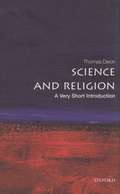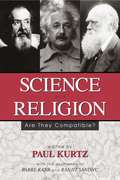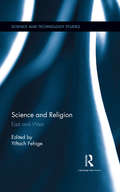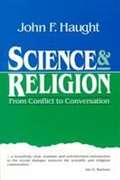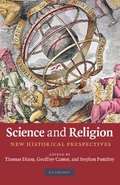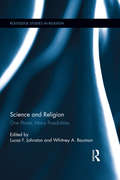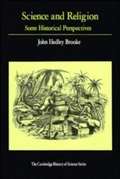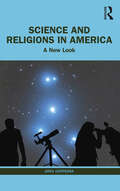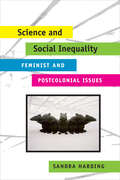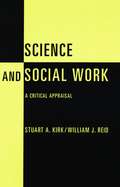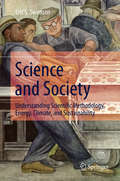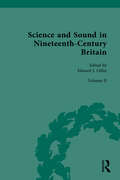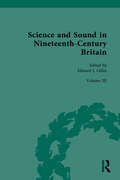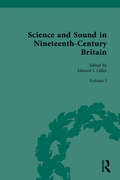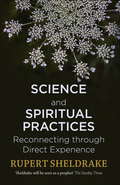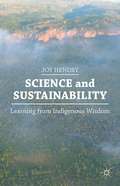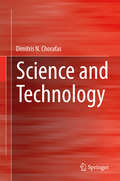- Table View
- List View
Science and Religion: A Very Short Introduction
by Thomas DixonThe debate between science and religion is never out of the news: emotions run high, fueled by polemical bestsellers like The God Delusion and, at the other end of the spectrum, high-profile campaigns to teach "Intelligent Design" in schools. Yet there is much more to the debate than the clash of these extremes. As Thomas Dixon shows in this balanced and thought-provoking introduction, a whole range of views, subtle arguments, and fascinating perspectives can be found on this complex and centuries-old subject. He explores the key philosophical questions that underlie the debate, but also highlights the social, political, and ethical contexts that have made the tensions between science and religion such a fraught and interesting topic in the modern world. Dixon emphasizes how the modern conflict between evolution and creationism is quintessentially an American phenomenon, arising from the culture and history of the United States, as exemplified through the ongoing debates about how to interpret the First-Amendment's separation of church and state. Along the way, he examines landmark historical episodes such as the Galileo affair, Charles Darwin's own religious and scientific odyssey, the Scopes "Monkey Trial" in Tennessee in 1925, and the Dover Area School Board case of 2005, and includes perspectives from non-Christian religions and examples from across the physical, biological, and social sciences.
Science and Religion: An Introduction for Youth
by Holmes Rolston IIIThis is written for young people, grades 9-12, to read on their own, with others their age, as well as with parents and teachers.How is the scientific method similar to and different from the way that Christians think? One tends to see what one is looking for. Those who think about religion also use such frameworks. They may call them creeds. Both science and religion open up "big questions." Scientists seek causes; believers seek meanings.The origin and creation of the universe displays some surprising features. Physicists have found dramatic connections between astronomical and atomic scales that combine to make the Earth and its life possible. The mid-range scales where the most complex things are found depend on the interacting microscopic and astronomical ranges. The universe is "user-friendly."Scientific concepts of the origin of life are very different from the Genesis creation stories. Genetics is about creating, storing, elaborating information. The Genesis stories are a parable that reveals the meaning of creation. Biological science does discover a wonderland Earth. The Genesis parable affirms a land of promise, today an Earth with promise.The human mind is the most complex thing in the known universe. How much science of persons can psychologists have? Neuroscience has discovered remarkably plastic, flexible minds. Resolute behavior, especially in youth, re-shapes our minds. Humans have huge cognitive power gained by speech and language. Jesus teaches us to love God and neighbor. The two great commandments are not the facts of any science.The knowledge and wisdom of past and present transmitted to the future in cultures is as important as what we inherit genetically. How are youth shaped by their rearing, by their peer groups? How do people behave socially in groups: government, politics, churches, economics, and business? Also, evaluating ethical responsibilities for love and justice demands religious and philosophical judgments.Contemporary scientists have added a new science. What of artificial intelligence, of massive computing power? This aids science, makes possible new discoveries. Youth have pages on Facebook. They twitter. How will this behavior affect their adult character? Youth hear a lot about STEM - science, technology, engineering, math. Youth need faith and ethics to evaluate the values in STEM.Natural and cultural histories require searching for meanings. History is more narrative, the stories of personal life that shape history: Abraham, Muhammad, Jesus, Martin Luther, Martin Luther King, Israel, England, America, and the Second World War Youth today will write the history of this first century of the new millennium, with challenges as painful as ever. To do that with justice and love, they need the wisdom of the Christian faith. XX
Science and Religion: Approaches from Science and Technology Studies
by Zara Thokozani KamwendoThis edited volume offers new and exciting perspectives on the social study of science and religion through current scholarship grounded in Science and Technology Studies (STS). The contributors explore how STS theories, methods, and concepts can be applied to the study of religion, as well as how to incorporate aspects of religion into STS. The purpose of the volume is to advance the social study of science and religion by fostering the already interdisciplinary nature of the field and to encourage engagement with the intersection between science and religion from a wide range of perspectives.
Science and Religion: Are They Compatible?
by Paul Kurtz Contribution by Barry Karr Ranjit SandhuIn recent years a noticeable trend toward harmonizing the distinct worldviews of science and religion has become increasingly popular. Despite marked public interest, many leading scientists remain skeptical that there is much common ground between scientific knowledge and religious belief. Indeed, they are often antagonistic. Can an accommodation be reached after centuries of conflict? <P><P> In this stimulating collection of articles on the subject, Paul Kurtz, with the assistance of Barry Karr and Ranjit Sandhu, have assembled the thoughts of scientists from various disciplines. Among the distinguished contributors are Sir Arthur C. Clarke (author of 2001: A Space Odyssey, and numerous other works of science fiction); Nobel Prize Laureate Steven Weinberg (professor of physics at the University of Texas at Austin); Neil deGrasse Tyson (Princeton University astrophysicist and director of the Hayden Planetarium); James Lovelock (creator of the Gaia hypothesis); Kendrick Frazier (editor of the Skeptical Inquirer); Steven Pinker (professor of psychology at MIT); Richard Dawkins (zoologist at Oxford University); Eugenie Scott (physical anthropologist and executive director of the National Center for Science Education); Owen Gingerich (professor of astronomy at Harvard University); Martin Gardner (prolific popular science writer); the late Richard Feynman (Nobel Prize-winning physicist) and Stephen Jay Gould (professor of geology at Harvard University); and many other eminent scientists and scholars. <P><P> Among the topics discussed are the Big Bang and the origin of the universe, intelligent design and creationism versus evolution, the nature of the "soul," near-death experiences, communication with the dead, why people do or do not believe in God, and the relationship between religion and ethics.
Science and Religion: East and West (Science and Technology Studies)
by Yiftach FehigeThis volume situates itself within the context of the rapidly growing interdisciplinary field that is dedicated to the study of the complex interactions between science and religion. It presents an innovative approach insofar as it addresses the Eurocentrism that is still prevalent in this field. At the same time it reveals how science develops in the space that emerges between the ‘local’ and the ‘global’. The volume examines a range of themes central to the interaction between science and religion: ‘Eastern’ thought within ‘Western’ science and religion and vice versa, and revisits thinkers who sought to integrate ‘Eastern’ and ‘Western’ thinking. It studies Zen Buddhism and its relation to psychotherapy, Islamic science, Vedantic science, atheism in India, and Darwinism, offering in turn new perspectives on a variety of approaches to nature. Part of the Science and Technology Studies series, this volume brings together original perspectives from major scholars from across disciplines and will be of great interest to scholars and students of science and technology studies, history of science, philosophy of science, religious studies, and sociology.
Science and Religion: From Conflict to Conversation
by John F. HaughtA guide to dialogue between scientists and believers.
Science and Religion: New Historical Perspectives
by Thomas Dixon Geoffrey Cantor Stephen PumfreyThe debate between science and religion is never out of the news: emotions run high, fuelled by polemical bestsellers like The God Delusion and, at the other end of the spectrum, high-profile campaigns to teach "Intelligent Design" in schools. Yet there is much more to the debate than the clash of these extremes. As Thomas Dixon shows in this balanced and thought-provoking introduction, a whole range of views, subtle arguments, and fascinating perspectives can be found on this complex and centuries-old subject. He explores the key philosophical questions that underlie the debate, but also highlights the social, political, and ethical contexts that have made the tensions between science and religion such a fraught and interesting topic in the modern world. Dixon emphasizes how the modern conflict between evolution and creationism is quintessentially an American phenomenon, arising from the culture and history of the United States, as exemplified through the ongoing debates about how to interpret the First-Amendment's separation of church and state. Along the way, he examines landmark historical episodes such as the Galileo affair, Charles Darwin's own religious and scientific odyssey, the Scopes "Monkey Trial" in Tennessee in 1925, and the Dover Area School Board case of 2005, and includes perspectives from non-Christian religions and examples from across the physical, biological, and social sciences.
Science and Religion: One Planet, Many Possibilities (Routledge Studies in Religion)
by Whitney A. Bauman Lucas F. JohnstonThis collection offers new perspectives on the study of science and religion, bringing together articles that highlight the differences between epistemological systems and call into question the dominant narrative of modern science. The volume provides historical context for the contemporary discourse around religion and science, detailing the emergence of modern science from earlier movements related to magic and other esoteric arts, the impact of the Reformation on science, and the dependence of Western science on the so-called Golden Age of Islam. In addition, contributors examine the impacts of Western science and colonialism on the ongoing theft of the biological resources of traditional and indigenous communities in the name of science and medicine. The volume’s multi-perspectival approach aims to refocus the terms of the conversation around science and religion, taking into consideration multiple rationalities outside of the dominant discourse.
Science and Religion: Some Historical Perspectives
by John Hedley BrookeOne of the most fascinating and enduring issues in the development of the modern world is the relationship between scientific thought and religious belief. It is common knowledge that in Western societies there have been periods of crisis when new science has threatened established religious authority. The trial of Galileo in 1633 and the uproar caused by Darwin's Origin of Species(1859) are two famous examples. Taking account of recent scholarship in the history of science, Professor Brooke takes a fresh look at these and similar episodes, showing that science and religion have been mutually relevant in such a rich variety of ways that simple generalizations are not possible. Standing back from general theses affirming "conflict" or "harmony," which have so often served partisan interests, the author's object is to reveal the subtlety, complexity, and diversity of the interaction of science and religion as it has taken place in the past and in the twentieth century. Instead of treating science and religion as discrete definable entities, his approach is sensitive to shifting boundaries and willing to consider the contexts in which particular forms of science could be used both for religious and secular ends. The result is that, without assuming specialist knowledge, Brooke provides a wide-ranging study from the Copernican innovation to in vitro fertilization.
Science and Religions in America: A New Look
by Greg CootsonaWhat is religion? What is science? How do they interact with each other? Science and Religions in America: A New Look offers a cutting-edge overview of the diverse range of religious traditions and their complex and fascinating interaction with science. Pluralistic in scope, the book is different from traditional Christian and/or monotheistic approaches to studying the rich interplay of religion and science in multi-religious American culture. Featuring interviews with specialists in the field, Greg Cootsona draws on their insights to provide a comprehensive, accessible, and engaging introduction to the challenging interrelationship of religion and science. Each chapter focuses on a different religion within the United States, covering Buddhism, Christianity, Nature Religions, Islam, Judaism, Hinduism, and the Spiritual but Not Religious (SBNR). Global religious traditions and their inextricable relationship with science and technology are examined in an accessible and interactive format. With "lightning round Q&As," contributions from leading thinkers, and suggestions for further reading, this book primes undergraduate students for studying the interchange of science and religions (in the plural) and is an exciting new resource for those interested in these topics in contemporary America.
Science and Social Inequality: Feminist and Postcolonial Issues (Race and Gender in Science Ser.)
by Sandra HardingHarding argues that the philosophy and practices of today's Western science, contrary to its enlightenment mission, actually work to insure that more science will only worsen existing gaps between the best and worst of societies around the world.
Science and Social Inequality: Feminist and Postcolonial Issues (Race and Gender in Science)
by Sandra HardingIn Science and Social Inequality, Sandra Harding makes the provocative argument that the philosophy and practices of today's Western science, contrary to its Enlightenment mission, work to insure that more science will only worsen existing gaps between the best and worst off around the world. She defends this claim by exposing the ways that hierarchical social formations in modern Western sciences encode antidemocratic principles and practices, particularly in terms of their services to militarism, the impoverishment and alienation of labor, Western expansion, and environmental destruction. The essays in this collection--drawing on feminist, multicultural, and postcolonial studies--propose ways to reconceptualize the sciences in the global social order. At issue here are not only social justice and environmental issues but also the accuracy and comprehensiveness of our understandings of natural and social worlds. The inadvertent complicity of the sciences with antidemocratic projects obscures natural and social realities and thus blocks the growth of scientific knowledge. Scientists, policy makers, social justice movements and the consumers of scientific products (that is, the rest of us) can work together and separately to improve this situation.
Science and Social Work: A Critical Appraisal
by William J. Reid Stuart KirkScience and Social Work is a critical appraisal of the strategies and methods that have been used to develop knowledge for social work practice. It identifies the major ways in which social workers have drawn upon scientific knowledge and techniques, placing each one in historical perspective by explaining the nature of the problems it was designed to solve and the philosophical, political, and practical questions it raised. Kirk and Reid offer a balanced appraisal of the promises, accomplishments, and limits of such approaches, demonstrating how the fruits of scientific research can aid clinical practice with individuals, families and groups.
Science and Society
by Eric S. SwansonThis undergraduate textbook educates non-science majors--our future policy makers--on how science works, the rules that underpin our existence, our impact on nature, and nature's impact on us. The book provides a concise, historically based, non-mathematical treatment of modern physics relevant to societal issues. It challenges readers to examine the problems we face (and their own beliefs) in light of the scientific method. With a narrative structure, Science and Society explains the scientific process and the power it brings to dealing with the natural world. The reader will gain a deeper understanding of scientific results reported by the media, and thus the tools to develop a rational, fact-based assessment of energy and resource policy. Praise for Science and Society: "Anyone who thinks society can be managed without science should think again, or better: read this book. Eric Swanson explains how science permeates society, and with simple examples of the scientific process he shows its special power in dealing with the natural world. This is a must read for the world's seven billion scientists. " F. E. Close, OBE, Oxford University, author of, among others, "Half-Life: The Divided Life of Bruno Pontecorvo, Physicist or Spy", "The Infinity Puzzle", and "Neutrino"
Science and Sound in Nineteenth-Century Britain: Philosophies and Epistemologies of Sound (Nineteenth-Century Science, Technology and Medicine: Sources and Documents #2)
by Edward J. GillinScience and Sound in Nineteenth-Century Britain is a four-volume set of primary sources which seeks to define our historical understanding of the relationship between British scientific knowledge and sound between 1815 and 1900. In the context of rapid urbanization and industrialization, as well as a growing overseas empire, Britain was home to a rich scientific culture in which the ear was as valuable an organ as the eye for examining nature. Experiments on how sound behaved informed new understandings of how a diverse array of natural phenomena operated, notably those of heat, light, and electro-magnetism. In nineteenth-century Britain, sound was not just a phenomenon to be studied, but central to the practice of science itself and broader understandings over nature and the universe. This collection, accompanied by extensive editorial commentary, will be of great interest to students and scholars of the History of Science.
Science and Sound in Nineteenth-Century Britain: Sound Transformer (Nineteenth-Century Science, Technology and Medicine: Sources and Documents #4)
by Edward J. GillinSound and Science in Nineteenth-Century Britain is a four-volume set of primary sources which seeks to define our historical understanding of the relationship between British scientific knowledge and sound between 1815 and 1900. In the context of rapid urbanization and industrialization, as well as a growing overseas empire, Britain was home to a rich scientific culture in which the ear was as valuable an organ as the eye for examining nature. Experiments on how sound behaved informed new understandings of how a diverse array of natural phenomena operated, notably those of heat, light, and electro-magnetism. In nineteenth-century Britain, sound was not just a phenomenon to be studied, but central to the practice of science itself and broader understandings over nature and the universe. This collection, accompanied by extensive editorial commentary, will be of great interest to students and scholars of the History of Science.
Science and Sound in Nineteenth-Century Britain: Sound in Context (Nineteenth-Century Science, Technology and Medicine: Sources and Documents #3)
by Edward J. GillinScience and Sound in Nineteenth-Century Britain is a four-volume set of primary sources which seeks to define our historical understanding of the relationship between British scientific knowledge and sound between 1815 and 1900. In the context of rapid urbanization and industrialization, as well as a growing overseas empire, Britain was home to a rich scientific culture in which the ear was as valuable an organ as the eye for examining nature. Experiments on how sound behaved informed new understandings of how a diverse array of natural phenomena operated, notably those of heat, light, and electro-magnetism. In nineteenth-century Britain, sound was not just a phenomenon to be studied, but central to the practice of science itself and broader understandings over nature and the universe. This collection, accompanied by extensive editorial commentary, will be of great interest to students and scholars of the History of Science.
Science and Sound in Nineteenth-Century Britain: Sounds Experimental and Entertaining (Nineteenth-Century Science, Technology and Medicine: Sources and Documents #1)
by Edward J. GillinSound and Science in Nineteenth-Century Britain is a four-volume set of primary sources which seeks to define our historical understanding of the relationship between British scientific knowledge and sound between 1815 and 1900. In the context of rapid urbanization and industrialization, as well as a growing overseas empire, Britain was home to a rich scientific culture in which the ear was as valuable an organ as the eye for examining nature. Experiments on how sound behaved informed new understandings of how a diverse array of natural phenomena operated, notably those of heat, light, and electro-magnetism. In nineteenth-century Britain, sound was not just a phenomenon to be studied, but central to the practice of science itself and broader understandings over nature and the universe. This collection, accompanied by extensive editorial commentary, will be of great interest to students and scholars of the History of Science.
Science and Spiritual Practices: Reconnecting through direct experience
by Rupert SheldrakeIn this pioneering book Rupert Sheldrake shows how science helps validate seven practices on which all religions are built, and which are part of our common human heritage:· Meditation· Gratitude· Connecting with nature· Relating to plants· Rituals· Singing and chanting· Pilgrimage and holy places. The effects of spiritual practices are now being investigated scientifically as never before, and many studies have shown that religious and spiritual practices generally make people happier and healthier. Rupert Sheldrake summarizes the latest scientific research on what happens when we take part in these practices, and suggests ways that readers can explore these fields for themselves. For those who are religious, Science and Spiritual Practices will illuminate the evolutionary origins of their own traditions and give a new appreciation of their power. For the non-religious, this book will show how the core practices of spirituality are accessible to all, even if they do not subscribe to a religious belief system. This is a book for anyone who suspects that in the drive towards radical secularism, something valuable has been left behind. Rupert Sheldrake believes that by opening ourselves to the spiritual dimension we may find the strength to live more wholesome and fulfilling lives.
Science and Spiritual Practices: Reconnecting through direct experience
by Rupert SheldrakeIn this pioneering book Rupert Sheldrake shows how science helps validate seven practices on which all religions are built, and which are part of our common human heritage:· Meditation· Gratitude· Connecting with nature· Relating to plants· Rituals· Singing and chanting· Pilgrimage and holy places. The effects of spiritual practices are now being investigated scientifically as never before, and many studies have shown that religious and spiritual practices generally make people happier and healthier. Rupert Sheldrake summarizes the latest scientific research on what happens when we take part in these practices, and suggests ways that readers can explore these fields for themselves. For those who are religious, Science and Spiritual Practices will illuminate the evolutionary origins of their own traditions and give a new appreciation of their power. For the non-religious, this book will show how the core practices of spirituality are accessible to all, even if they do not subscribe to a religious belief system. This is a book for anyone who suspects that in the drive towards radical secularism, something valuable has been left behind. Rupert Sheldrake believes that by opening ourselves to the spiritual dimension we may find the strength to live more wholesome and fulfilling lives.
Science and Spiritual Practices: Reconnecting through direct experience
by Rupert SheldrakeIn this pioneering book Rupert Sheldrake shows how science helps validate seven practices on which all religions are built, and which are part of our common human heritage:· Meditation· Gratitude· Connecting with nature· Relating to plants· Rituals· Singing and chanting· Pilgrimage and holy places. The effects of spiritual practices are now being investigated scientifically as never before, and many studies have shown that religious and spiritual practices generally make people happier and healthier. Rupert Sheldrake summarizes the latest scientific research on what happens when we take part in these practices, and suggests ways that readers can explore these fields for themselves. For those who are religious, Science and Spiritual Practices will illuminate the evolutionary origins of their own traditions and give a new appreciation of their power. For the non-religious, this book will show how the core practices of spirituality are accessible to all, even if they do not subscribe to a religious belief system. This is a book for anyone who suspects that in the drive towards radical secularism, something valuable has been left behind. Rupert Sheldrake believes that by opening ourselves to the spiritual dimension we may find the strength to live more wholesome and fulfilling lives.
Science and Sustainability
by Joy HendryIndigenous science is often dismissed as quackery or nonsense, out of touch with progress and current events. However, Indigenous peoples have passed down vital information for generations, from which local plants help cure common ailments, to which parts of the land are unsuitable for buildings because of likely earthquakes. These scientific practices that have been developed by Indigenous peoples around the world have been largely ignored by Western colonizers in their lands. From Japan and New Zealand to Australia and Canada, Indigenous science involves environmentally-focused, sustainable practices that allow people to live with the land rather than in spite of it. Here, Hendry examines science through these Indigenous roots, problematizing the idea that Western science is the only type that deserves that name and drawing attention to some of its shortcomings. She takes the reader with her on the learning process and shares a myriad of sustainable examples that can be put into practice.
Science and Sustainability
by University of California at Berkeley Lawrence Hall of ScienceScience and Sustainability is a different kind of science course. It not only covers many of the scientific concepts usually included in biology, chemistry, and physics classes, but also relates those concepts to issues of sustainability. Most likely, you have already explored many scientific concepts, but you may not be familiar with the term sustainability. Sustainability refers to the ability of populations of living organisms to continue, or sustain, a healthy existence in a healthy environment "forever."
Science and Technical Writing: A Manual of Style
by Philip RubensWith this new edition, Science and Technical Writing confirms its position as the definitive style resource for thousands of established and aspiring technical writers. Editor Philip Rubens has fully revised and updated his popular 1992 edition, with full, authoritative coverage of the techniques and technologies that have revolutionized electronic communications over the past eight years.
Science and Technology
by Dimitris N. ChorafasThe aim of this book is to explore science and technology from the viewpoint of creating new knowledge, as opposed to the reinterpretation of existing knowledge in ever greater but uncertain detail. Scientists and technologists make progress by distinguishing between what they regard as meaningful and what they consider as secondary or unimportant. The meaningful is dynamic; typically, the less important is static. Science and technology have made a major contribution to the culture and to the standard of living of our society. From antiquity to the present day, the most distinguished scientists and technologists have been thinkers, experimenters and persons willing and able to challenge "the obvious". Technology develops products and processes based on the breakthroughs of science. If technologists fail to steadily upgrade their skills, tools and methods, they will only be as good as their last design, risking obsolescence. Using practical examples and case studies, this book documents the correlations existing between science and technology, and elucidates these correlations with practical applications ranging from real-life situations, from R&D to energy production. As it is a salient problem, and a most challenging one to our society, power production has been chosen as a major case study. The holistic approach to science and technology followed by this text enhances the ability to deliver practical results. This book is intended for students and researchers of science, technology and mathematical analysis, while also providing a valuable reference book for professionals. Its subject is one of the most debated problems of mankind.
